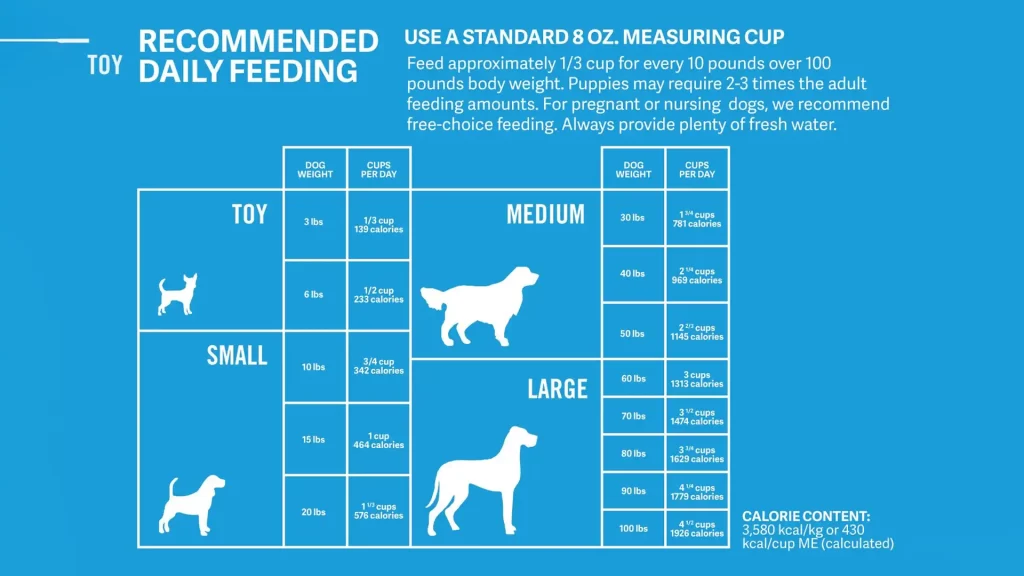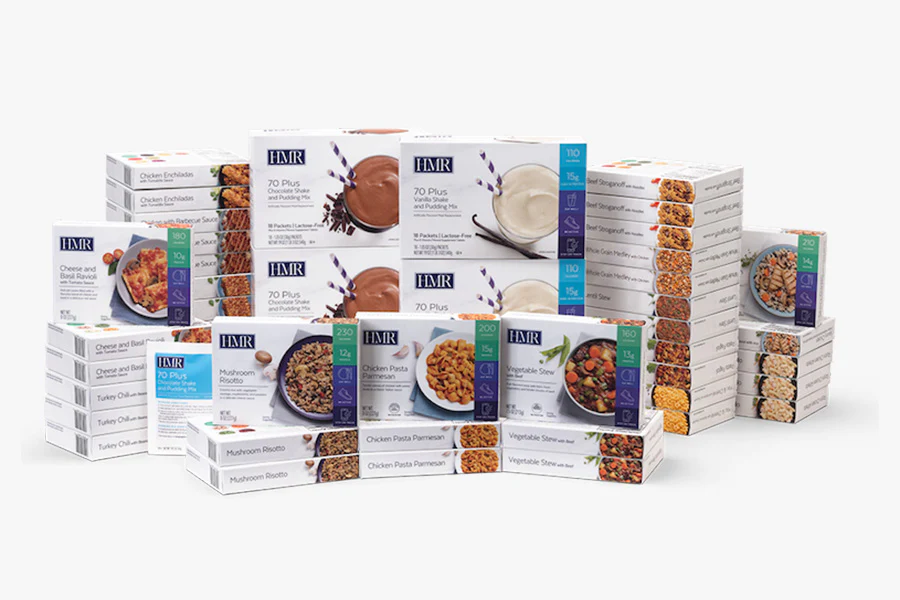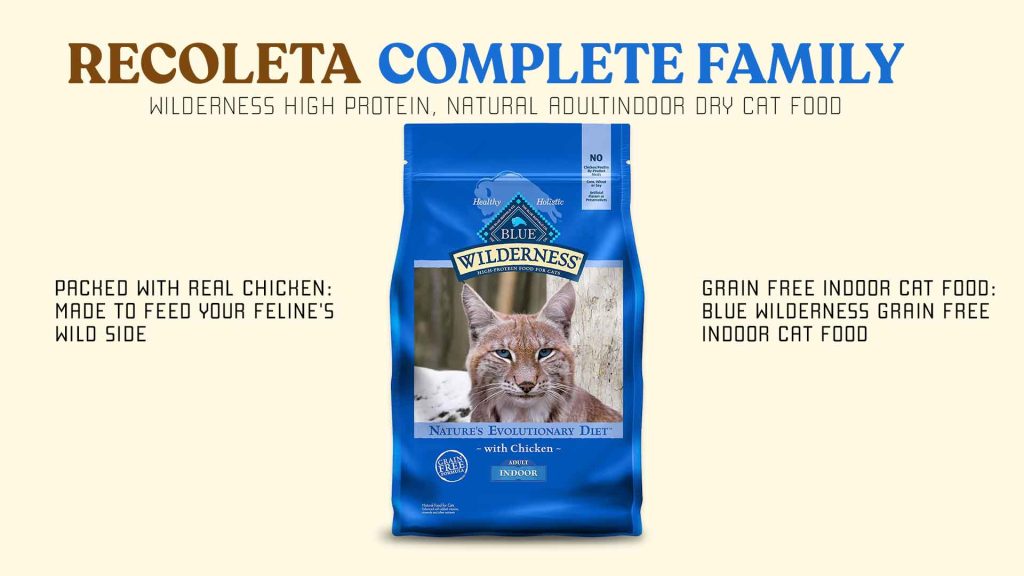The fascinating issue of “How much food should I feed my dog?” is important since it affects their entire health and well-being.
Giving your pet the nourishment they need may help them maintain a healthy weight, avoid health issues linked to obesity, and ensure they have the energy to play and exercise.
Your dog’s nutritional requirements are influenced by a number of variables, including size, age, exercise level, and general health. To help you decide how much food to give your dog, consider the following basic principles.
Read the dog food bag’s feeding directions. (How much food to feed my dog)
On their package, the majority of dog food manufacturers provide feeding recommendations. These recommendations are normally determined by the weight and age of your dog. However, bear in mind that these suggestions are simply general advice and could not be applicable to all dogs.
Think about how active your dog is. (How much food to feed my dog)
More active dogs need more calories than less active canines to do. A couch potato dog may need fewer calories than one that likes to go on long runs or walks. When deciding how much food to give your dog each day, keep in mind how active they are.
Be aware of your dog’s weight. (How much food to feed my dog)
Monitoring your dog’s weight is one of the most reliable methods to find out whether you are giving them the proper quantity of food. You are probably feeding your dog the proper amount if they are maintaining a healthy weight. You may need to limit your dog’s food consumption if it’s gaining weight. You may need to boost their food intake if they are losing weight.
Distribute the daily amount throughout several meals. (How much food to feed my dog)
It is recommended to give your dog many smaller meals throughout the day rather than one large meal. This may lessen the likelihood of digestion issues and overeating. Puppies could need to eat more often than adult dogs, who typically require two meals each day.
Avert overeating. (How much food to feed my dog)
Overeating may create obesity, which in turn can result in a number of health issues, such as diabetes, heart disease, and joint issues. Don’t overfeed your dog on snacks or table scraps, and be sure to measure their food properly.
In summary, How much food should I give my dog?
The quantity of food you should give your dog will vary depending on its size, age, degree of activity, and general health. In order to make sure your dog is receiving the nourishment they need without overeating, you may follow the feeding instructions on the food package, keep an eye on your dog’s weight, and divide their food consumption between many meals. If you have any queries or worries about the food of your dog, never hesitate to contact your veterinarian.
How can I figure out how much food my dog should eat?
When determining how much food to give my dog, it’s important to take into account their size, age, amount of activity, and general health. Here is a common formula to help you choose how much food to give your dog:
Calculate how many calories your dog needs each day: Your dog’s daily calorie needs are influenced by their weight and degree of exercise.
A tiny, passive dog, for instance, could only need 200–300 calories a day, but a big, energetic dog might need as many as 2,000 calories or more. Your veterinarian can assist you in figuring out how many calories your dog needs each day.
Once you are aware of how many calories your dog needs each day, you should evaluate the calorie content of the food you are feeding him. The majority of dog food packaging includes a calorie count per cup or serving.
Divide the total amount of calories by the number of meals: Divide the total number of calories your dog needs each day by the number of meals you want to give them. The majority of adult dogs eat twice a day. However, pups could need more frequent feedings.
Depending on the demands of your dog, adjust the amount: The suggested feeding recommendations on dog food packages are only suggestions.
Depending on your dog’s age, weight, level of activity, and general health, you may need to modify the quantity of food you are providing him. Regularly check your dog’s weight and make any dietary adjustments.
It’s crucial to remember that each dog is unique and that these are just basic recommendations. Always seek advice from your veterinarian if you have any queries or concerns regarding the nutrition of your dog or if you need assistance figuring out how much food to give them.

What does a cup of dog food cost?
Typically, a cup of dog chow weighs 8 ounces or 226 grams. The density and nature of the meal will affect how much food really fits in a cup, however. For example, dry dog food such as kibble may weigh less than wet or canned dog food.
The fact that various dog food companies could use different cup measures is also crucial to know. It’s crucial to adhere to the feeding guidelines on the particular brand of dog food you’re using since some brands may provide a smaller or bigger cup size than others.
Use a measuring cup or kitchen scale to precisely measure the food your dog consumes to make sure you are giving him the proper quantity of food based on his weight and feeding recommendations. By monitoring your dog’s food consumption, you can avoid overfeeding them and make sure they are receiving the right nutrients for good health.
How can I tell whether I’m giving my dog enough to eat?
Trying to figure out whether you are giving your dog enough food might be difficult. Here are several indicators that your dog may not be receiving enough food though:
Weight loss: Your dog may not be receiving enough food if they are losing weight and its ribs or bones are showing.
Low energy or sluggish behavior: If your dog exhibits signs of fatigue, lethargic behavior, or lack of energy, it may indicate that they are not consuming enough calories.
Asking or scavenging for food: If your dog is consistently asking for food or rummaging through the trash, it may indicate a lack of food.
Low coat condition: A dull, dry, or brittle coat in your dog may indicate low nutrition from a lack of food intake.
Frequent vomiting or diarrhea may indicate that your dog is not receiving enough food or that the food they are eating does not satisfy its nutritional requirements. If your dog is often vomiting or having diarrhea, this might be a problem.
On the other side, overfeeding may result in obesity and health issues. Therefore it’s important to routinely check your dog’s weight and make any dietary adjustments. It’s also crucial to adhere to the feeding instructions on your dog food packaging, and if you have any queries or concerns regarding your dog’s diet or feeding practices, speak with your veterinarian.
Does a dog need only one cup of food?
A dog’s nutritional requirements vary depending on its size, age, degree of exercise, and general health. Therefore, a dog’s ability to survive on 1 cup of food will rely on these variables.
One cup of food per day may be sufficient for certain tiny dog breeds or less active dogs to satisfy their daily nutritional requirements. One cup of food may not be enough to satisfy a dog’s energy needs if it is bigger or more active, and it may need more.
Following the feeding instructions on your dog food packaging is crucial. You should also speak with your veterinarian to establish the right quantity of food to give your dog, depending on their individual requirements.
It’s crucial to give your dog the proper quantity of food to maintain its ideal health since underfeeding may result in malnutrition and other health problems, and overfeeding can lead to obesity and other concerns.
Why only eat twice a day do dogs?
Dogs can eat more than twice a day, but the feeding pattern is often determined by the digestive system and the way the dog naturally eats.
Like their wolf forebears, dogs are omnivorous creatures who hunt and consume enormous meals sporadically in the wild, sometimes going several days without eating. They have a sluggish digesting process and a digestive system built to manage heavy meals.
A dog’s digestion and energy levels are regulated and maintained throughout the day by feeding it twice a day. As the dog has time to digest the meal before eating again, it also helps to avoid obesity and overeating. A regular feeding schedule may also help some dogs create a pattern and lessen their anxiety.
However, depending on the dog’s age, size, amount of activity, and health, the feeding schedule may change.
Highly active dogs may need more food and more frequent feedings, whereas puppies and older dogs may need more frequent meals. Always talk to your doctor about the best feeding regimen for your dog, depending on its individual requirements.
How often should a dog go potty?
A dog’s bowel motions may be more or less frequent depending on their age, food, level of activity, and general health.
Dogs normally urinate 1-3 times each day, on average. Monitoring your dog’s unique bowel movement habits is necessary to spot any changes or anomalies.
Insufficient bowel movements in your dog may be an indication of constipation, which may be brought on by dehydration, a lack of nutritional fiber, or an underlying medical issue. On the other side, excessive poops from your dog may be a sign of diarrhea, which may be brought on by dietary changes, food allergies, infections, or other medical conditions.
Contact your veterinarian to identify the underlying reason and obtain the appropriate care if you observe any changes in your dog’s bowel movement habits, such as diarrhea, constipation, or bloody stool. In order to preserve your dog’s digestive health, make sure they have access to clean water, balanced food, and frequent exercise.
A list of how much food I should give my dog.
You should take your dog’s weight, age, degree of activity, and the kind of food you are feeding them into account when calculating how much food to give them.
A basic recommendation is to give your dog 1-2 meals each day, with the quantity of food advised depending on their individual requirements and the feeding instructions on the dog food container.
To prevent overfeeding or underfeeding, it’s important to measure your dog’s food consumption using a measuring cup or kitchen scale. You should also routinely check your dog’s weight and general health. If you have any queries or worries regarding your dog’s food or feeding practices, speak with your veterinarian.






